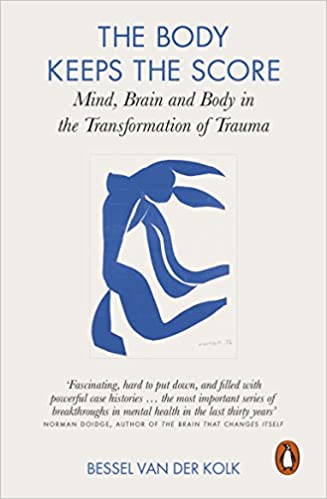The Body Keeps the Score — Book Summary
Introduction
This book presents itself as an invaluable resource to help those who want to know more about the psychological effects of trauma. Its author, the psychiatrist Dr. Bessel van der Kolk, introduces us to the idea of psychological trauma – what it means, and how to successfully deal with it.
Interesting quotes from the book
As long as you keep secrets and suppress information, you are fundamentally at war with yourself.
— Bessel van der Kolk, The Body Keeps the Score
Being able to feel safe with other people is probably the single most important aspect of mental health; safe connections are fundamental to meaningful and satisfying lives.
— Bessel van der Kolk, The Body Keeps the Score
Neuroscience research shows that the only way we can change the way we feel is by becoming aware of our inner experience and learning to befriend what is going on inside ourselves.
— Bessel van der Kolk, The Body Keeps the Score
Summary of the book The Body Keeps the Score
The Basics: Trauma as a Part of Life
In this quintessential personal development guide, Dr. Van der Kolk immerses himself and the reader into the real roots of trauma. A medical expert with almost four decades of experience working on the effects of trauma and brain development (especially in children), Dr. Van der Kolk has published more than a hundred studies about treating trauma efficiently. His findings have proven to be essential and applicable to many fields, from the educational one to healthcare, amongst others. Over these decades treating patients from a variety of backgrounds, he has compiled a collection of strategies to help victims of trauma to overcome their challenges and for society to understand and comprehend trauma from a more holistic and compassionate prism.
A New Discovery and a Pivotal Effort
The author narrates this book as if he is presenting the story of his life and career. Although the subject matter is complex, Dr. Van der Kolk knows how to facilitate the reading experience as he uses an unpretentious writing style and also simplified terminology. The book is intended to be divided into five parts. Each one of these segments represent the essence and nature of trauma and its branches. The author covers a multitude of subtopics with great respect and expertise. From identifying and labelling trauma, through studying the body-brain connection, to finding the light in the tunnel by compiling successful techniques to healing and recovery. Every passage of this book aims to provide a beacon of hope in the light of an empiric and analytical scientific research.
The Renaissance of Trauma
For those familiar with the term of trauma, sometimes it carries ineffectual connotations. However, Van der Kolk's recognized very early on in his career that there was a forceful connection between traumatic experiences and inner awakening. To be able to heal properly from any type of traumatic stress, a tremendous effort has to be done to acknowledge what we feel, think and know. He continues explaining that all these elements are interrelated and have to be confronted.
The Body-Brain Connection
According to Van der Kolk's research, and following Charles Darwin's steps, the communication between body and mind is of paramount importance. Prioritizing this connection, he says, is vital. To back up his arguments, he also mentions the well-known Polyvagal Theory introduced by Stephen Porges. This theory centers around the idea that the vagus nerve – previously studied by Darwin – is actually connected with different organs in our bodies, including the heart, the intestines, and the brain, amongst others. He clarifies that this understanding reflects the direct correlation between the stimulus from our environment and how the biology of our bodies processes these experiences as its own.
The Nature of Trauma
Van der Kolk's specialized explanation of the impact of trauma on the brain, mind, and body is particularly illustrative. He declared that there was an equivalence between experiencing trauma and losing one's motivation. What is also mentioned is that traumatized people often lose their sense of purpose rapidly since they are the ones to suppress many emotions and the body's natural responses. This constant destructive approach may be seen as a defensive strategy. However, as unnatural as it is, it quickly depletes the body of energy, leaving it working in "survival" mode. Consequently, traumatized patients may feel trapped in this never-ending cycle.
The Highway to Freedom
But there is hope. For Van der Kolk, to be free means to be able to confront reality with love, compassion and truth. In his book, he summarizes three pathways for treatment. He does not prefer one treatment per se but encourages his readers to experiment with a variety of resources and techniques. A big believer of neuroplasticity, this book presents the following heling triad:
1. Top-down or the "talking cure." Processing of the memories of trauma with the help of psychoanalysis remains a popular tool to address traumatic events.
2. Medication. The transformative power of antipsychotic medicines has led to a medical revolution. However, Van der Kolk concludes there is also a downside. It is important to treat the need and also the underlying issues.
3. Bottom-up or dealing with the autonomic nervous system (ANS). This is a regulation technique, involving psychomotor and somatic therapy. It means that we can recalibrate our system through movement, breath, and touch.
What can we learn from the book The Body Keeps the Score?
There are essential steps to recovery that can be summarized as key lessons from this book:
Lesson 1: Open yourself and communicate your fears
To truly resonate with our own body's emotions and responses, we need to be able to open ourselves and to face our inner fears.
Lesson 2: Learn to trust again
We need to let go of shame and learn how to trust again. A slow process, we need to teach ourselves and our brain to gradually let go of the old patterns.
Lesson 3: Be flexible, understanding and compassionate toward yourself
Trauma is part of everyone's life. The more understanding we get on the matter, the more compassion we will show toward ourselves and toward others.
Lesson 4: Be a unique leader
Find ways to become calm and learn to maintain this attitude in every situation that may remind you of the past. Lead yourself into balance and regulation.
Lesson 5: Learn to believe in the future
Neuroplasticity has confirmed that our brain (and our essence) can change for the better. It is imperative to create and maintain a growth mindset to facilitate progress in our lives.
Review of the book The Body Keeps the Score
I found this book to be an innovative, clarifying resource for all types of people, especially those interested in psychiatry and psychology. Van der Kolk has written a pioneering manual to help and instruct general public about the reality of trauma. Its goal is accomplished: to create more awareness in our society about the impact of trauma but also about the human potential to overcome challenges.
Pros
- Didactic, revolutionary research and information provided.
- The author's voice is approachable and compassionate.
- There are plenty of real case studies exemplifying the horrors of trauma but also the road to recovery.
Cons
- Some of the content exposed in the book may sound very graphic to many.
- Readers will need to do further research to comprehend some scientific terms.
- Extended scientific research may overwhelm the average reader and may prevent him/her from finishing the book.
Conclusion
After finishing this book, I feel more confident dealing with the effects of trauma, both as a professional and as a member of society. The book has switched my focus to be more centered on the benefits of neuroplasticity, and interpersonal neurobiology. I have also learned more about the lasting lessons of self-regulation and how to find pleasure and hope in the future even in the midst of the pain.
Don't miss the other book summaries on SunInMe.org

